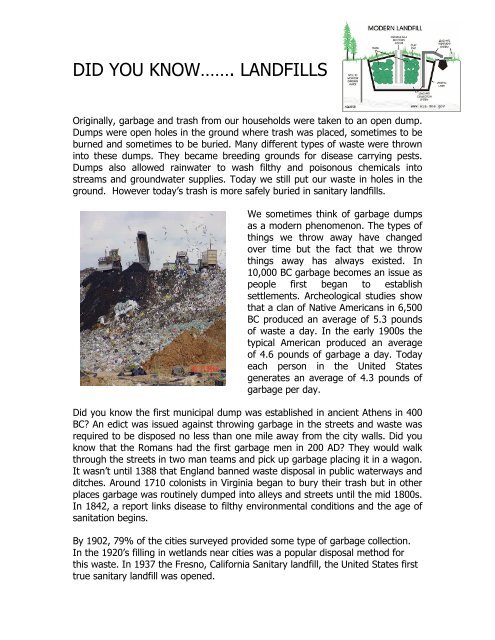DID YOU KNOW……. LANDFILLS
DID YOU KNOW……. LANDFILLS
DID YOU KNOW……. LANDFILLS
You also want an ePaper? Increase the reach of your titles
YUMPU automatically turns print PDFs into web optimized ePapers that Google loves.
<strong>DID</strong> <strong>YOU</strong> <strong>KNOW……</strong>. <strong>LANDFILLS</strong><br />
Originally, garbage and trash from our households were taken to an open dump.<br />
Dumps were open holes in the ground where trash was placed, sometimes to be<br />
burned and sometimes to be buried. Many different types of waste were thrown<br />
into these dumps. They became breeding grounds for disease carrying pests.<br />
Dumps also allowed rainwater to wash filthy and poisonous chemicals into<br />
streams and groundwater supplies. Today we still put our waste in holes in the<br />
ground. However today’s trash is more safely buried in sanitary landfills.<br />
We sometimes think of garbage dumps<br />
as a modern phenomenon. The types of<br />
things we throw away have changed<br />
over time but the fact that we throw<br />
things away has always existed. In<br />
10,000 BC garbage becomes an issue as<br />
people first began to establish<br />
settlements. Archeological studies show<br />
that a clan of Native Americans in 6,500<br />
BC produced an average of 5.3 pounds<br />
of waste a day. In the early 1900s the<br />
typical American produced an average<br />
of 4.6 pounds of garbage a day. Today<br />
each person in the United States<br />
generates an average of 4.3 pounds of<br />
garbage per day.<br />
Did you know the first municipal dump was established in ancient Athens in 400<br />
BC? An edict was issued against throwing garbage in the streets and waste was<br />
required to be disposed no less than one mile away from the city walls. Did you<br />
know that the Romans had the first garbage men in 200 AD? They would walk<br />
through the streets in two man teams and pick up garbage placing it in a wagon.<br />
It wasn’t until 1388 that England banned waste disposal in public waterways and<br />
ditches. Around 1710 colonists in Virginia began to bury their trash but in other<br />
places garbage was routinely dumped into alleys and streets until the mid 1800s.<br />
In 1842, a report links disease to filthy environmental conditions and the age of<br />
sanitation begins.<br />
By 1902, 79% of the cities surveyed provided some type of garbage collection.<br />
In the 1920’s filling in wetlands near cities was a popular disposal method for<br />
this waste. In 1937 the Fresno, California Sanitary landfill, the United States first<br />
true sanitary landfill was opened.
When Did It<br />
Happen??<br />
10,000 B.C.<br />
Settlements<br />
established<br />
6,500 B.C.<br />
Average waste<br />
produced per person is<br />
5.3 pounds<br />
400 BC.<br />
First municipal dump<br />
in Athens Greece<br />
200 A.D.<br />
First garbage men in<br />
Rome<br />
1388 A.D.<br />
Waste disposal in<br />
public waterways<br />
banned in England<br />
1710 A.D.<br />
Virginia colonists<br />
began to bury their<br />
trash<br />
1842 A.D.<br />
Age of sanitation<br />
begins<br />
A sanitary landfill is a permitted facility designed for the<br />
burial of wastes. It consists of several liner systems that are<br />
scientifically designed to reduce hazards to public health and<br />
to protect the environment.<br />
Did you know that the waste generated by the average<br />
person in this country is composed of 35% paper, 12% yard<br />
trimmings, 11% food scraps, 11% plastics and 31% metals,<br />
glass, wood and other things. All these items go into your<br />
sanitary landfill.<br />
Did you know that you could make your own edible landfill?<br />
For more information, visit www.ldeq.org or call<br />
225.219.3273.















